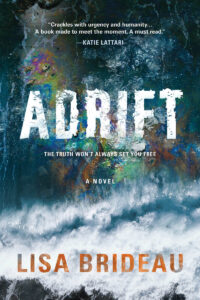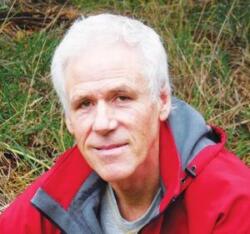Serious entertainment
Adrift
by Lisa Brideau
Naperville, IL: Sourcebooks Landmark, 2023
$25.99 / 9781728265681
Reviewed by Theo Dombrowski
*

Adrift. The very word creates a haunting image of a boat without purpose, power, or direction, its moorings and bearings lost. Stir a metaphor into the mix, and the image is now of a person lost in much the same ways. The double images are absolutely appropriate to this novel, Adrift, by Vancouver-based first-time novelist, Lisa Brideau.
The images are, however, absolutely inappropriate to the novel. Why? Because although the title meshes smoothly with the storyline, the whole book is, in nearly all ways, anything but adrift. It is controlled, crafted, deliberate—and, to boot, utterly purposeful.
And lest this suggest that the experience for the reader will be, er, smooth sailing, the opposite is true. In fact, it would be fitting to wrench the sailing analogy enough to say that the reader will encounter threatening narrative storms, hidden reefs, puzzling crosscurrents, dizzying whirlpools, and just about anything any other bit of adrenalin boost a rough passage can produce.
Entertaining? Fun? Yes. And these are also words the author herself uses to describe the book, or at least one side of it.
In addition, Brideau points out that she hopes Adrift “sparks conversations”—though she is being conservative. Instead of “conversations” what her book is geared to provoke are intense discussions, some reflective, others impassioned.
Managing this double impact has, traditionally, been within the scope of many literary genres, but perhaps none more than science fiction. The author herself uses the term “speculative fiction,” which suggests an outlandish premise that’s nevertheless within the bounds of plausibility. The one premise the author does require her readers to accept is that soon to come (operative words) are drugs intended to treat PTSD, with the power to target and erase patients’ memories of events but not their daily skills or acquired general knowledge or even expertise. The corollary, the wary reader will be quick to sense, is that the effect and handling of such a drug could go seriously… adrift.
Rather than setting the novel just a few years down the road, Brideau chooses 2039. And 2039 is where the second major set of premises becomes not just somewhat plausible, but frighteningly so.
Many readers will feel that our entire world now is directly on course to face the kinds of climate changes the novel brings to terrifying life. Here’s a world afflicted with sea level rise, wildfires, droughts, and storms—bad enough in themselves—and with the tragic consequence, crucial to the novel, of climate refugees by the millions. It is a reflection of Brideau’s craft that she deftly melds these two premises into a gripping plot. It is testament to her intelligence and concern for humanity that the storyline itself is alive with social and personal issues.

Much of the author’s craft underlies the fast moving plot. Brideau knows how to assemble a skookum array of provocative elements. First, there are cryptic—and threatening—messages, mysterious in origin and significance. Arising from these comes the double thrust of the main action—both a flight from little understood danger and a frantic, anxious quest to solve a deeply personal mystery.
The author inserts physical crises, some of them, especially in the early part of the novel, incidental and passing, but enough to keep the writing electric—broken equipment, storms, and nearly lethal sailing accidents among them. Lockstep with the increasing tension is increasing physical danger as the mysteries unfurl and characters shift from friend to enemy; troublingly too, dangerous figures emerge from the shadows.
Carefully crafted schemes, violent confrontations, frantic escapes, ticking countdowns, dire accidents, life-threatening injuries: they’re all there, and they’re all as integral to the action as sinews and tendons to a body. Lest the reader’s attention waver for a second, Brideau ensures that the reader alert to even a minor character at the beginning of the novel will be rewarded with revelations at the end. A minor, throwaway character? Not a whit.
To describe these elements of the plot, though, is to be a little misleading. A full-blown thriller this novel is indeed, but it’s simultaneously a novel where the author sees her characters not as action figures but as complex individuals. They’re shot through with shifting emotions and riven by thoughts and concerns. In some ways, in fact, even on the level of storyline, Adrift is as much about relationships and self-discoveries as about quests and flights.
In order to achieve these ends, Brideau introduces memorable minor characters. There’s Raven, for instance, a wise, no-nonsense Indigenous woman, simultaneously shrewd and caring. And Hito and Yori, a brother and sister. The author portrays the siblings vividly and allows them to shift and surprise. Hito is, apparently, a meticulously rational, self-directed, and ambitious member of the Harbour Authority. But only apparently. On the surface Yori seems Hito’s opposite, chaotically fumbling through issues of addiction, undermined by her own failures, and no longer capable of being the successful painter she once was.
Besides using the pair to drive the plot, the author also gives them memorable dialogue. “Who knows who they were before,” asks Hito about now incarcerated immigrants, “war criminals, terrorists, people who put pineapple on pizza.” The irrepressible Yori is even edgier: “I may have gotten… a little revengey,” she confides about her ex-lover. “I mean, I can’t let that kind of thing go without repercussion, so I may have set the tiniest of fires in her backyard.”
Partly, it is the shifts in the readers’ response to these characters that’s arresting, but equally it’s what that causes these shifts. More accurately, it’s who, not what.
Enter the protagonist, Ess. For, yes, the author taps into the genre-honoured tradition of following the fortunes of a single character. But is she a “character” at all? Her documented name is Sarah; even that, she feels, is too much. Abject, Brideau’s protagonist reduces her name simply to S—or Ess. And this is a fundamental irony and stirring insight in the novel. Even though Ess feels that she has no depth, Brideau implies that she does indeed have considerable depth. In part, the author does so by showing that Ess’ relationship with Hito and Yori leads directly to positive change.
Brideau targets the cause of Ess’s bleak view of herself as the propelling force of the entire novel.
The story begins with Ess waking but devoid of a single memory about herself—such as who she is or how she arrived on an anchored sailboat near Haida Gwaii. Other storytellers begin with a similar case of amnesia. What Brideau does with this beginning, however, is use her protagonist’s amnesia to propel not only the plot, but a whole sequence of thoughtful, even unsettling questions. Unsurprisingly, a seminal question arises from the nature of memory itself. That leads to careful exposition of, for example, the distinction between “semantic” and “episodic” memory. (The author has done her homework.)
In terms of action, the desperate need to remember drives Ess to follow a clue she finds on her sailboat. In the process, she undertakes a harrowing solo sailing trip to Nanaimo, the setting for the rest of the novel (complete with Nanaimo bars and the Bastion). The courage, resourcefulness, analytical intelligence, and deep emotion that drive Ess are the first suggestions that a woman who feels she has no identity because she has no personal memory, perhaps, really does have considerable identity. What Ess achieves in Nanaimo, from relentlessly tracking down leads and throwing her entire being into finding out who she “really” is—and all despite mysterious warnings not to search—further creates a vivid sense of a caring and committed woman.
Yet, hounded by her feelings about the connection between identity and memory, she admits to Yori, “I didn’t think I could matter to you…. There is no me to know.” The response from this redoubtable woman is telling: “Bullshit…. this idea that you’re going to get back to your old life and suddenly be a real person. You are a real person.” The author, readers can’t help but feel, agrees with Yori.
It is part of the psychological subtlety of the novel, though, that Brideau doesn’t conclude Adrift with a flat-footed, fully spelled-out revelation. True, she does provide just enough of an explanation to keep the potentially harrumphing reader satisfied.
Instead, she shifts ground to an entirely different kind of resolution. As the author states in the Q and A at the close of the book: “This is life—it’s messy and we don’t usually get the clear answers we want.” In Brideau’s hands, identity becomes more—much more—than an accumulation of memories. It becomes (existentialists take note) a fluid, self-determining series of choices. As Ess thinks, “if she wanted connections with people, it was up to her to make it happen. She had always been in control of that.”
One of the most affecting choices Ess makes is to deny her own drive for personal satisfaction in order to support Yori, in crisis at that point. Another—and this is where an important vision of the novel meshes closely with the action—is to engineer a dangerous manoeuvre that will bring hope to trapped climate refugees caught within a governmental bureaucracy driven by protectionism and fear at the expense of humane values.
For as much as this novel is “about” memory and identity, it is just much “about” the desperate situation of climate refugees, and, more specifically, Canada’s responsibility within the framework of climate crisis.
Within the storyline, Brideau uses two particularly dramatic elements to heighten the crisis. First, she places the most dangerous and fraught parts of the plots and counterplots during the worst climate-change-driven storm on record. Second, she depicts the machinations of profiteers who take advantage of the desperation of climate refugees: the fact that these refugees are Americans fleeing to Canada raises yet another problematic—but pressing—issue. But the issues spread even wider.
Exactly how important these issues are to the author is reflected in the fact that she adds both an epilogue and a pointed essay on climate change. In the latter she relates the facts behind the climate crisis with razor sharp clarity, even listing web links. In the former, she states, “Canada’s massive historic contribution to the climate change crisis creates an obligation to assist those suffering the devastating impacts.” In some ways, of course, this is exactly what Brideau is doing in writing this novel—instilling in her readers a compulsion to engage with a whole national policy “to assist those suffering the devastating impacts.”
*

Born on Vancouver Island, Theo Dombrowski grew up in Port Alberni and studied at University of Victoria and later in Nova Scotia and London, England. With a doctorate in English literature, he returned to teach at Royal Roads, University of Victoria, and finally Lester Pearson College in Metchosin. He also studied painting and drawing at Banff School of Fine Arts and University of Victoria. He lives at Nanoose Bay. Visit his website here. [Editor’s note: Theo Dombrowski has written and illustrated several coastal walking and hiking guides, including Secret Beaches of the Salish Sea (Heritage House, 2012), Seaside Walks of Vancouver Island (Rocky Mountain Books, 2016), and Family Walks and Hikes of Vancouver Island (RMB, 2018, reviewed by Chris Fink-Jensen), as well as When Baby Boomers Retire. He has reviewed books by Brady Marks and Mark Timmings, Darrel J. McLeod, Max Wyman, Dustin Cole, Deborah Willis, Lindsay Wong, and Bill Engleson for BCR.]
*
The British Columbia Review
Interim Editors, 2023-25: Trevor Marc Hughes (nonfiction), Brett Josef Grubisic (fiction)
Publisher: Richard Mackie
Formerly The Ormsby Review, The British Columbia Review is an on-line book review and journal service for BC writers and readers. The Advisory Board now consists of Jean Barman, Wade Davis, Robin Fisher, Barry Gough, Hugh Johnston, Kathy Mezei, Patricia Roy, Maria Tippett, and Graeme Wynn. Provincial Government Patron (since September 2018): Creative BC. Honorary Patron: Yosef Wosk. Scholarly Patron: SFU Graduate Liberal Studies. The British Columbia Review was founded in 2016 by Richard Mackie and Alan Twigg.
“Only connect.” – E.M. Forster
One comment on “Serious entertainment”